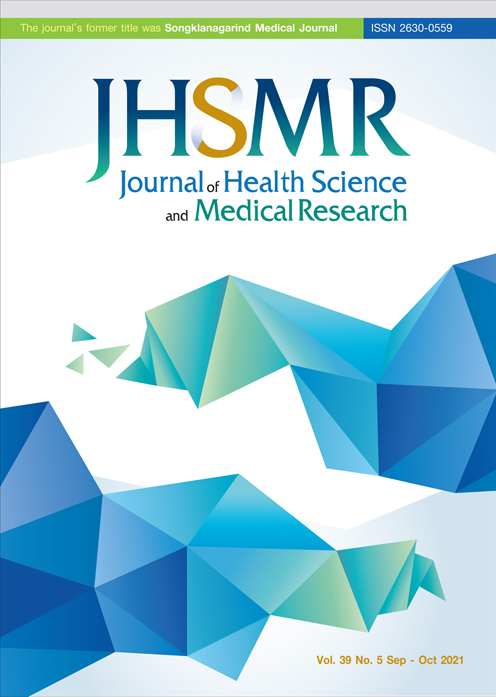Overexpression of 14-3-3γ Induces the Migration and Invasion of Human Lung Adenocarcinoma A549 Cells
DOI:
https://doi.org/10.31584/jhsmr.2021796Keywords:
14-3-3γ, A549 cells, epithelial‑mesenchymal transition, invasion, migrationAbstract
Objective: 14-3-3 gamma (γ) is known to modulate the development and progression of many cancers. However, the evidence in lung cancer is still unclear. In this study, effects of 14-3-3γ on tumor cell migration and invasion were investigated.
Material and Methods: A 14-3-3γ expression vector was made and transfected into A549 cells. In-vitro scratch assay and transwell assay were applied to assess migration and invasion, respectively. Western blotting was used to detect expression of proteins related to epithelial–mesenchymal transition.
Results: Closing rate of scratch wounds, both in classical and non-classical scratch assay, was significantly increased in 14-3-3γ-overexpressing cells in comparison to the controls. Similarly, by transwell assay, a significant increase in the invasion and migration was shown in the 14-3-3γ-overexpressing cells in comparison to the null vector cells, by approximately 79.2% (p-value=0.002) and 131.2% (p-value<0.001), respectively. In addition, increased 14-3-3γ expression resulted in a significant increase of β-catenin and Snail but not for E-cadherin and vimentin.
Conclusion: The study demonstrates the role of 14-3-3γ protein on lung cancer progression via migration and invasion processes, possibly providing a new targeted therapy for non-small cell lung cancer.
References
Bray F, Ferlay J, Soerjomataram I, Siegel RL, Torre LA, Jemal A. Global cancer statistics 2018: GLOBOCAN estimates of incidence and mortality worldwide for 36 cancers in 185 countries. CA Cancer J Clin 2018;68:394-424.
Seyfried TN, Huysentruyt LC. On the origin of cancer metastasis. Crit Rev Oncog 2013;18:43-73.
Hanahan D, Weinberg RA. The hallmarks of cancer. Cell 2000;100:57-70.
Son H, Moon A. Epithelial-mesenchymal Transition and Cell Invasion. Toxicol Res 2010;26:245-52.
Friedl P, Wolf K. Tumour-cell invasion and migration: diversity and escape mechanisms. Nat Rev Cancer 2003;3:362-74.
Aitken A. 14-3-3 proteins: a historic overview. Semin Cancer Biol 2006;16:162-72.
Yaffe MB. How do 14-3-3 proteins work?-- Gatekeeper phosphorylation and the molecular anvil hypothesis. FEBS Lett 2002;513:53-7.
Fu H, Subramanian RR, Masters SC. 14-3-3 proteins: structure, function, and regulation. Annu Rev Pharmacol Toxicol 2000; 40:617-47.
Song Y, Yang Z, Ke Z, Yao Y, Hu X, Sun Y, et al. Expression of 14-3-3gamma in patients with breast cancer: correlation with clinicopathological features and prognosis. Cancer Epidemiol 2012;36:533-36.
Ko BS, Lai IR, Chang TC, Liu TA, Chen SC, Wang J, et al. Involvement of 14-3-3gamma overexpression in extrahepatic metastasis of hepatocellular carcinoma. Hum Pathol 2011;42: 129-35.
Raungrut P, Wongkotsila A, Lirdprapamongkol K, Svasti J, Geater SL, Phukaoloun M, et al. Prognostic significance of 14-3-3gamma overexpression in advanced non-small cell lung cancer. Asian Pac J Cancer Prev 2014;15:3513-8.
Raungrut P, Wongkotsila A, Champoochana N, Lirdprapamongkol K, Svasti J, Thongsuksai P. Knockdown of 14-3-3gamma Suppresses Epithelial-Mesenchymal Transition and Reduces Metastatic Potential of Human Non-small Cell Lung Cancer Cells. Anticancer Res 2018;38:3507-14.
Wang B, Wang T, Cao XL, Li Y. Critical genes in head and neck squamous cell carcinoma revealed by bioinformatic analysis of gene expression data. Genet Mol Res 2015;14: 17406-15.
Wang YB, Jia N, Xu CM, Zhao L, Zhao Y, Wang X, et al. Selecting key genes associated with osteosarcoma based on a differential expression network. Genet Mol Res 2015;14: 17708-17.
Ajjappala BS, Kim YS, Kim MS, Lee MY, Lee KY, Ki HY, et al. 14-3-3gamma is stimulated by IL-3 and promotes cell proliferation. J Immunol 2009;182:1050-60.
Radhakrishnan VM, Martinez JD. 14-3-3gamma induces oncogenic transformation by stimulating MAP kinase and PI3K signaling. PLoS One 2010;5:e11433.
Lee IN, Chen CH, Sheu JC, Lee HS, Huang GT, Yu CY, et al. Identification of human hepatocellular carcinoma-related biomarkers by two-dimensional difference gel electrophoresis and mass spectrometry. J Proteome Res 2005;4:2062-9.
Qi W, Liu X, Qiao D, Martinez JD. Isoform-specific expression of 14-3-3 proteins in human lung cancer tissues. Int J Cancer 2005;113:359-63.
Qi W, Liu X, Chen W, Li Q, Martinez JD. Overexpression of 14-3-3gamma causes polyploidization in H322 lung cancer cells. Mol Carcinog 2007;46:847-56.
Gomes CJ, Centuori SM, Harman MW, Putnam CW, Wolgemuth CW, Martinez JD. The induction of endoreduplication and polyploidy by elevated expression of 14-3-3gamma. Genes Cancer 2017;8:771-83.
Hiraoka E, Mimae T, Ito M, Kadoya T, Miyata Y, Ito A, et al. Breast cancer cell motility is promoted by 14-3-3gamma. Breast Cancer 2019;26:581-93.
Hou Z, Peng H, White DE, Wang P, Lieberman PM, Halazonetis T, et al. 14-3-3 binding sites in the snail protein are essential for snail-mediated transcriptional repression and epithelial-mesenchymal differentiation. Cancer Res 2010;70: 4385-93.
Tong S, Xia T, Fan K, Jiang K, Zhai W, Li JS, et al. 14-3-3zeta promotes lung cancer cell invasion by increasing the Snail protein expression through atypical protein kinase C (aPKC)/NF-kappaB signaling. Exp Cell Res 2016;348:1-9.
Yang Y, Liu Y, He JC, Wang JM, Schemmer P, Ma CQ, et al. 14-3-3zeta and aPKC-iota synergistically facilitate epithelialmesenchymal transition of cholangiocarcinoma via GSK-3beta/ Snail signaling pathway. Oncotarget 2016;7:55191-210.
Chen CH, Chuang SM, Yang MF, Liao JW, Yu SL, Chen JJ. A novel function of YWHAZ/beta-catenin axis in promoting epithelial-mesenchymal transition and lung cancer metastasis. Mol Cancer Res 2012;10:1319-31.
Lai XJ, Ye SQ, Zheng L, Li L, Liu QR, Yu SB, et al. Selective 14-3-3gamma induction quenches p-beta-catenin Ser37/ Bax-enhanced cell death in cerebral cortical neurons during ischemia. Cell Death Dis 2014;5:e1184.
Hermeking H. The 14-3-3 cancer connection. Nat Rev Cancer 2003;3:931-43.
Hollestelle A, Peeters JK, Smid M, Timmermans M, Verhoog LC, Westenend PJ, et al. Loss of E-cadherin is not a necessity for epithelial to mesenchymal transition in human breast cancer. Breast Cancer Res Treat 2013;138:47-57.
Downloads
Published
How to Cite
Issue
Section
License

This work is licensed under a Creative Commons Attribution-NonCommercial-NoDerivatives 4.0 International License.
























